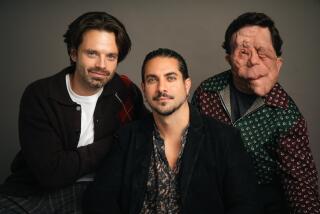You would swear they can breathe
At age 9, Adrien Morot started making casts of his own face using plaster bandages he had stolen from the school nurse’s office. By age 12, he had set his house on fire using flammable rubber and had been called into the principal’s office for coming to school with fake bloody stumps in place of his fingers. Three decades later, the Montreal-born artist traveled the world to make life casts of Hank Azaria, Amy Adams and many of the actors in “Night at the Museum: Battle of the Smithsonian.”
“It’s kind of weird, but ever since I saw the first ‘Planet of the Apes’ movie, I fell in love with makeup,” he says. “And then, of course, 1977 came and was the year of ‘Star Wars,’ and that just blew me away, and I knew that that’s what I had to do in life. And if not, I would be a very unhappy person.”
Happiness was not without its perils. Some of Morot’s experiments with a molding material called alginate yielded, well, unexpected results. “My dad used to give me two dollars per day to eat at school, so I basically didn’t eat for two weeks, and I saved my two dollars every day,” he says. “And then I took my bike, and I bought a can of alginate. I had read in a magazine somewhere -- it was probably some Ukrainian magazine or something -- that you could do life casts of heads with eyes open. So the first thing I did is I mixed a little batch on my kitchen counter, and I stuck it right into my eyeball. And for about three minutes, I was holding my eye like, ‘Ahhh!’ ”
After attending a horror convention in Los Angeles and receiving seven job offers on the strength of his portfolio, Morot opted to scrap plans to study art history at the University of Montreal and turn professional. Since then, he’s worked on films including “The Day After Tomorrow,” “300” and “Meet Dave.” For “Night at the Museum: Battle of the Smithsonian,” he molded a fine collection of dummies -- without sustaining any optical injuries.
No house of wax: To populate the museums, Morot and his team molded 15 to 20 stunningly life-like mannequins. “We did all of the life casts of all of the actors,” he recalls. “For the first movie, [‘Night at the Museum’], we tried to do stuff looking like the Hollywood Wax Museum, and all the makeup on the actors playing the wax figures was done to look a little bit overshadowed, a little too opaque. And for the second movie, we tried to do them as realistically as possible, and we put out some of the most realistic dummies I’ve seen.”
Making the mold: Morot employs the same materials he used as a preteen to create his life casts. “Basically, we take the stuff called alginate, the stuff that you do dental impressions with,” he explains. “And you ask the actor what flavor he likes. ‘Mint or strawberry or . . . oh no, sorry. We just have dirty dust flavor!’ And so we mix that with water and we apply that all over the face or the body, if we need to. And it’s about five to eight minutes to set. Then you have this rubbery mask all over the actor’s head. Then you put plaster bandages -- the same stuff that you use when you break your arm -- on top of your alginate. So it’s a two-step process. Once those plaster bandages are set, you basically de-mold the guy. You remove a cast from his head. And then you pour plaster -- or in our case we poured molten Plasticine in the casts. So we end up with those Plasticine heads of our actors.”
An eye for an eye: Morot has learned the hard way to always hand-sculpt the eyeballs. “It was on ‘Meet Dave’ that we found ways to do extremely accurate resemblances with precise measurements of the eyes, and it gives amazing results,” he says. “You basically sculpt your [mannequin] eyes. And then once you think you have something pretty good, you take pictures [of the mannequins] from the same distance as the reference pictures of the actors. And then on our computer, we superimpose the two pictures. I show it to the sculptors in the shop and am like, ‘Look here, the eye should be 2/16 of an inch further out this way.’ And we go back and forth like 10 to 15 times until we have it dead perfect.”
Packing light: While traveling from New York to Los Angeles to Vancouver to do life casts for “Battle of the Smithsonian,” Morot endured some very strange looks from TSA. “I have this plexiglass sheet, which is, like, 2 feet wide by 1 foot,” he says. “And on that, I have, like, 200 eyeballs of different colors, and I use that as a reference. It’s really weird passing through at the airport security, and they ask you to open up your thing, and you have a bag of eyeballs and skin color references.”
--
More to Read
The biggest entertainment stories
Get our big stories about Hollywood, film, television, music, arts, culture and more right in your inbox as soon as they publish.
You may occasionally receive promotional content from the Los Angeles Times.










